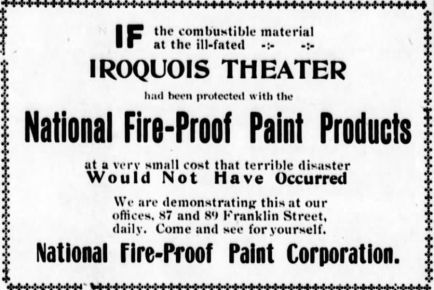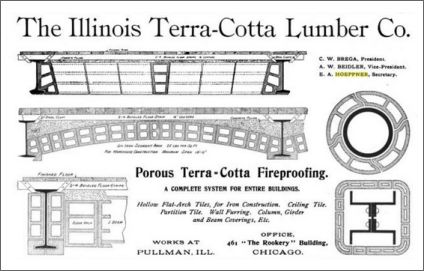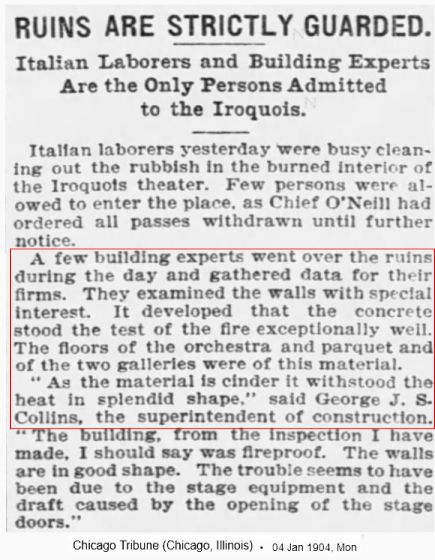|
In
1903, Chicago was home to America's worst theater
disaster, a record held still. The short
version of the story is that at the city's newly constructed
Iroquois Theater, a stage fire spread to the
auditorium and killed nearly six hundred people.
The longer version consumes this
website. This page is about one of
the scavengers who tried to capitalize on
tragedy.
There were street
thieves who stole belongings from
corpses, and a professional con who
stole a corpse. More common were advertisements for life
insurance companies and manufacturers of
products promised to simplify
firefighting or prevent gaseous fumes
during future such fires. National
Fire-Proof Paint went so far as to claim
the Iroquois disaster wouldn't have
happened had their paint been used at
the Iroquois. A few
life-insurance companies published the names
of their customers who had died in the fire — along
with the amount of their policy, and name of the beneficiary!

The subject of this page used the Iroquois disaster
to give his career a boost.
Twenty-five-year-old William Clendenin (1878–
1952) was a self-proclaimed fire expert who lived in Chicago.
He earned a living writing about fires in
commercial and municipal structures for
a Chicago-based publication named Fireproof Magazine. For
his employer, a trust of terra-cotta tile
producers, the magazine provided a way to pound
on its promotional message: concrete/cement
construction and sprinklers were very, very bad;
terra-cotta tile construction was perfect.
The #1 goal of Fireproof
magazine was to promote terra cotta tile
sales. The #1 goal of William
Clendenin was to build his brand.
Clendenin submitted his stories from the
magazine about large structural fires to newspapers
that were happy to receive free content
that drew eyeballs. Newspapers
didn't know enough about the fire to
recognize his deceptions and reject the story.
So avid was public interest in the Iroquois
Theater fire that newspapers published everything they could get
their hands on (including stories about people
who lived hundreds of miles from Chicago and
merely thought about going to the Iroquois
Theater, if they happened to be
in Chicago). Newspapers jumped on
Clendenin's Iroquois story. As do
bloggers and book authors over a
century later unaware of its
inaccuracies and falsehoods.
Clendenin ignored courtroom testimony
from hundreds of witnesses.
Most egregious was Clendenin's absurd claim that plaster rained
down in the Iroquois Theater auditorium, killing
people directly by falling atop
them and killing others indirectly by
increasing panic amongst people on the first
floor who thought the balconies were falling.
In ten years of studying weeks of published interviews and
testimony from survivors and first
responders, in dozens of newspapers in
six states, I've found zero talk about falling
plaster or fear of falling balconies.
Busy newspaper editors cannot have been
expected to recognize that the only one talking about
falling balconies was William Clendenin:
|
"The arch, or ceiling, was covered with
a cheap concrete. The first puff of flame
destroyed this. It crumbled
away, exposing the twisted mass of steel
reinforcement and girders, and fell on the
audience.
This killed many.
Looking from below, the
bewildered, choking and
maddened crowd thought
it was the result of a
panic above. They
believed the galleries
were falling and, in the
rush resulting, many
more were killed."
|
In addition to the absence of witness testimony,
evidence that Clendenin's attempt to blame deaths on concrete
is malarkey is found in the fact that only a handful of people sitting
on the first floor were killed, and they died
from falling bodies from the balconies, not falling concrete.
Check out the photo below taken the day after
the fire and you'll see two small patches of
plaster on the floor, each about 18" x 24" in
diameter. As Clendenin well knew,
fear of falling
balconies killed no one. His
deception was intentional.
|
|
|
In addition to falling plaster, Clendenin's alternate facts included:
Condemnation over the Iroquois being equipped with a poor quality fire curtain
Top-of-the-line or trash, the quality and construction of
the Iroquois fire curtain was as irrelevant
as what Eddie Foy ate for breakfast.
On its way down, the curtain hung up on an
obstacle,
a light fixture on the north side
of the proscenium arch, creating a gap between
the curtain wall and the stage floor that was large
enough to ride through on an elephant. A
backdraft into the superheated gaseous area of
the unventilated stage combusted and expelled a giant fireball
through that gap in the curtain into the
auditorium where it was drawn up to the
northeast corner of the structure by a
ventilation shaft fan and opened fire exits, killing the
roughly four hundred people
in the balconies who had not yet escaped. Given
the built-up heat on the unventilated stage, the
backdraft, and the gap below the fire curtain,
the death count would have been the same if the curtain had been made of
ten-inch-thick stainless steel.
Over a century of discussion about the quality
and construction of the Iroquois Theater fire
curtain has been pointless.
Corrupt Chicago politicians and city officials
Clendenin all but called Chicago mayor
Harrison playground names, but gave no
specifics or examples. The prior
year he had condemned Harrison's appointed
Building Commissioner, Peter Kiolbassa,
going so far as to blame the deaths of
fourteen people on Harrison and Kiolbassa—with a
similar lack of substantiation. During
a graft inquest a few weeks prior to the
Iroquois Theater fire, investigators reported
that of hundreds of tips received, a majority
were unverifiable. Clendenin's corruption
accusations were equally specious.
Concrete is the Devil's work
For Fireproof Magazine, every fire presented an opportunity
to condemn concrete and promote tile.
On a good day, they wedged in anti-sprinkler
stories, too. Cledenin made much about
wire lathe and cement used on the corners of the
proscenium arch at the Iroquois Theater and,
like the fire curtain, though irrelevant,
implied that it played a role in the fire.
|
The titular head of Fireproof Publishing Company was E. A.
Hoeppner, an officer in Terra-Cotta
Lumber Co. of Pullman, Illinois. Terra-Cotta Lumber
was owned by National Fire Proofing. From
1999 to 1902, NATCO had acquired twenty-nine
manufacturers of architectural terra cotta. This gave them control
of 65% of the industry.

Wonder if other
advertisers knew they were putting money
into a competitor's pocket. Probably.
Terra-cotta trusts got started around 1890
and Terra-Cotta Lumber was founded ten years
later. The first trust-busting investigations
came to their industry in 1909 and lasted a
decade. By 1920, price fixing had
become so much the norm that they didn't try very hard to conceal
it, like they knew their days were numbered.
Indictments, fines and prison
sentences for Sherman Act violations
came in 1922. The cement and concrete
trusts were broken up too, probably pleasing the
terra-cotta crowd no end.
|
|
 |
Party's over
Clendenin appears to have run afoul with his employer
about a year after the Iroquois Theater fire. The publisher
disassociated itself from him beginning in August 1904. Legal
notices began appearing in newspapers for a
month.

After writing for Fireproof, Clendenin went to work as an
advertising copywriter, first for an agency in
St. Louis then at several different Chicago agencies.
By 1930 he was working as a bookkeeper and by 1940 had disappeared,
presumably deceased. Fireproof
magazine was around until at least 1911.
|
People in Chicago's building trades knew Clandenin was a bad
actor. Architects and engineers challenged his assertions
in op-ed pieces but he continued until relieved of the
Fireproof assignment.

|
|
George J. Schilling Collins (1863–1927) was an
insurance agent turned construction engineer. He was born in London and
spent his boyhood in south Africa. His remarks might have been a
non-confrontational rebuttal of Clendenin's harangue two days earlier.
|
|
